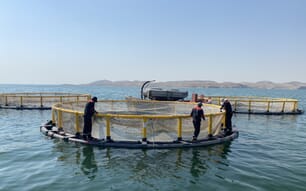The world’s first successful bluefin spawning in a dedicated onshore facility that can control water temperature and day length suggests potential for stable aqua farming, the independent administrative agency said Friday.
In the past, there have been reports of successful bluefin tuna spawning at facilities such as aquaculture ponds set up on the surface of the ocean or in aquariums, reports the JapanTimes.
Catches of bluefin, a popular but expensive food in Japan, are restricted because their numbers are dropping in the Pacific Ocean.
In 2002, Kinki University in Higashiosaka in Osaka succeeded in complete bluefin aqua farming, or raising tuna from eggs through to mature fish. The university’s technique is affected by natural conditions, however, because it uses aquaculture ponds on the ocean surface, which makes it difficult to produce bluefin eggs and juvenile fish on a stable basis.
The use of an dedicated onshore facility is expected to help gather stables supplies of eggs and fish.
The agency said it started farming 126 bluefin that were 2 years old and about a meter long in two round fish tanks measuring 20 meters in diameter and 6 meters deep, at its Seikai National Fisheries Research Institute in May last year. The temperatures were kept at 18 to 29 degrees and the daily amount of sunshine was kept close to natural conditions.
Spawning was first confirmed on May 16 and continues. The number of eggs produced has reached some 200,000, and several tens of thousands of juvenile bluefin have hatched, the agency said.
The agency said it will conduct an ecological study on bluefin tuna, including proper conditions for and frequency of spawning.
Keiichi Mushiake, head of the institute’s Research Center for Tuna Aquaculture, said he hopes 20 to 30 percent of farmed tuna will be produced from juvenile fish born artificially within 10 years.




